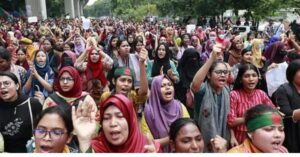In this essay, first the historical background of India is given, then its present condition is discussed, and finally its future is explored.
The reason behind using history is to show how in reality this idea of India existed long ago, albeit in a unique form. While many of our friends, inspired by Benedict Anderson’s Imagined Communities (1983) believe that any nation (India too) exists only in the imagination, historians like Irfan Habib and Mushirul Hasan give a contradictory view.
For Habib, it was the fight against colonialism and for Hasan, it was a common culture that made India truly a nation.
Past
The existence of India as a country had long preceded British rule. It was due to geography that cultural affinities developed distinguishing it from the rest of the world. The concept of India as a country is stronger in Persian writings of medieval times than the preceding Sanskrit writings, argues Irfan Habib. Hindus and Muslims shared Indo-Persian culture in north India, wrote Mushirul Hasan (Qasbas in Colonial Awadh).
Intizar Husain, a literary figure, said in his Dilli Tha Jis Ka Naam (2016) that the 1857 rebels saw India as their country, and its people, their natural reserve of supporters. The construction of railways, introduction of the telegraph, and the centralisation of the administration played their part in making Indians view India as a prospective single political entity. Modern education and the rise of press disseminated the ideas of India’s nationhood. The issue of poverty due to colonialism was felt equally throughout India (Irfan Habib, Indian Economy 1858-1914). Mahatma Gandhi, Jawaharlal Nehru, Khan Abdul Ghaffar Khan and many other revolutionaries shared the vision that India belongs to all who live in it.
We see, then, three complex processes enmeshed to bring about the emergence of India as a nation: the preceding notion of India as a country, the influx of modern political ideas, and the struggle against colonialism. This is not to deny that early India was not conflict-free, as has been shown by D. N. Jha (“Brahmanical Intolerance in Early India”).
Present
The partition of India in 1947 was undoubtedly a setback. One can read B. R. Ambedkar’s Communal Deadlock and a Way to Solve It (1945) in this regard. It, however, remains an achievement that India retained its secular character. It continues to have a Parliament and courts of law, political parties and a free press, and regular elections. The modern idea of democracy has taken deep root in this old civilisation. One of the remarkable facts about the nationalist elite that led India to Independence was its capacity to entertain diverse, often competing visions of India.
After Independence, Nehru’s vision of modernising India dominated. But it was not proved to be uniform across regions and over time. Corruption, violence, rule bending, all were practised. Institutional continuities, though, have endured. The Constitution of India has maintained its vision of a socialist and secular India. The Supreme Court and the Election Commission have successfully upheld not only the letter but also the spirit of the Constitution. Democratic ideas have seeped through the many layers of India’s society which has been and still remains marred by socio-economic inequality (Dr. Ambedkar and Democracy by Christophe Jaffrelot and Narender Kumar).
The success of democracy in India, however, has been threatened by a number of problems. The 1984 anti-Sikh pogrom in Delhi, the 1992 Babri Masjid demolition in U.P. and the 2008 anti-Christian pogrom in Odisha have reiterated that minorities are unsafe in the modern nation-state.
Perhaps the historical root of creating fake Hindu majority lies in the context of the Poona Pact, as shown by Joel Lee (2021). Dalits and Adivasis are labelled as Hindus, which denies them self-respect and a proper place in history. Bhanwar Meghwanshi (2020) talks about the contemporary challenges existing before India in his lucidly written memoir.
Nehru’s idea of India sought to co-ordinate within a modern state a variety of values: religious diversity, economic development, and federalism. India has managed to achieve success on many fronts, albeit partially. It has allowed its citizens to live together with a larger measure of freedom than ever before. The aspiration of economic liberalisation after 1990 has yielded a much uneven picture. Neoliberalism is increasing economic inequality and making the poor more and more vulnerable. After 2014, there has been a complete breakdown of civility in India, as Suryakant Waghmore (2021) says.
Future
We are aware that our idea of India has been critiqued by B.R. Ambedkar (States and Minorities) and is critiqued by his followers like G. Aloysius (Nationalism without a Nation in India). We agree that for a nation to be really a nation there must be a ‘we’ feeling. Each and every citizen must share trials and tribulations together. This is completely missing as we see how Hindu majority is indifferent to the plight of minorities (Dalits, Adivasis, Sikhs or Buddhists).
Historical roots of Hindu communalism have been traced by scholars like Joya Chatterji (Bengal Divided). Similarly, we have studies on Muslim subjectivity in colonial India by Ali Khan Mahmudabad (2020) and on Dalit subjectivity by Gail Omvedt (2005). The idea of India is under threat by growing economic inequality, patriarchy and ecological degradation, no doubt. The exclusion of historically marginalised groups remains relevant till today, argues Sukhadeo Thorat (2022).
No matter how contested the idea of India is, one is sure that it must be inclusive and self-reflexive. Our task for the future is to keep the flame of this ‘inclusivity’ and ‘self-reflexivity’ burning.
(It is written by Zeeshan Husain, a sociologist & Qayam Masumi, a social worker).




